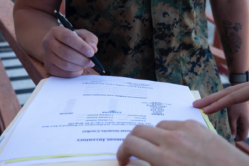If you’re expecting a tax refund, you obviously want to get it as quickly as possible. That way, you can put it to work for you sooner rather than later. The fastest and safest way to get your tax refund is to submit your return online, using e-file.
There are three ways to file your tax return electronically:
- Use your own tax software. Most tax programs, such as TurboTax and H&R Block, include the option to submit your return by e-file.
- Use a tax preparer. You can find an authorized e-file tax professional by clicking through a link on the IRS home page at irs.gov and entering your zip code.
- Use “Free File” on the IRS website. You’ll find it at irs.gov/freefile.
- Bonus method: Military members have several methods for filing their taxes free.
If you e-file and request a direct deposit, you’ll probably receive your funds in less than ten days. But if you submit a paper return and request a direct deposit or a paper check, it could take several weeks longer. Plus, you run the risk that your tax form(s) or refund check could get lost or stolen. If you don’t receive your refund, it’s important that you make an inquiry about it using the IRS refund status tool.
Table of Contents
- What to Do With Your Tax Refund
- 1. Convert Your Tax Refund into Your Emergency Fund
- 2. Chip Away at Debt
- 3. Save Part of Your Tax Refund for Everyday Use
- 4. Invest and Make It Grow
- 5. Use a Little Bit for Something Fun
- Determine Where to Send Your Tax Refund
- How Much is the Ideal Tax Refund?
- Adjust Withholdings if Your Refund Is Too Big
- Stay on Top of Your Finances
What to Do With Your Tax Refund
The average tax refund received for 2022 was $3,200, according to National Taxpayer Advocate.
Unless you have a plan for when you receive a check of that size, it can be pretty easy to squander the money away. Once you receive your refund, there are a gazillion things you can do with it. Taking a vacation or going on a shopping spree may immediately come to mind, but the best thing you can do with the money is save it or put it to another use. It might not be as much fun as other options, but it will certainly go a long way toward improving your personal finances.
1. Convert Your Tax Refund into Your Emergency Fund
One of the most important defenses you have against unexpected expenses or the loss of income is a cushy emergency fund. Most financial planners advise their clients to build an emergency fund of more than or, at least, equal to a full three to six months’ worth of living expenses. This includes money for the mortgage or rent, groceries, gas, insurance payments and other daily living expenses.
Unfortunately, a staggering 25% of Americans have nothing saved at all. An emergency fund will help you make it if you experience a personal, medical or financial catastrophe. So, while it may be tempting to use that nearly three grand as a down payment on a new car, you will be much better off in the long run if you use that money to create a financial cushion in the event of being laid off from your job, not being able to work because of medical reasons or if something catastrophic happens, like losing your home to a fire or a flood. Three grand isn’t three to six months’ worth of expenses, but it’s a great start.
2. Chip Away at Debt
As important as it is to have an emergency fund, it’s important to try to live debt-free as well. If you have mounting credit card payments or other bills, your tax refund can serve as a huge relief from some of your financial burdens. Decide whether to use your refund to pay off a smaller debt completely or use the money to chip away at a larger debt or debt with a high interest rate.
If, for example, you still owe $2,000 on a vehicle, you could use your refund to pay off that full amount. Then, since you have freed up $200-$300 a month in car payments, you can then use that money to pay toward a credit card or student loans instead. This is a good example of how the debt snowball works.
There is no one solution for how to best pay off debt. Look at your personal situation and evaluate how your tax refund can help you to put your best financial foot forward.
3. Save Part of Your Tax Refund for Everyday Use
Building an emergency fund and/or chipping away at debt should be your number one goal. But it is perfectly acceptable to save some of that money for daily use, especially if you have been strapped for cash.
A good way to use your refund is to save 20-30% of your refund into your checking account. Having enough money for gas, groceries, your kids’ activity fees and other unexpected expenses (like doctor copays, prescriptions, etc.) can help prevent you from having to add even more money to your credit card debt.
4. Invest and Make It Grow
Already have savings and don’t have any debt? A tax refund can be a perfect way to add more fuel to your financial fire by investing. You can never have too much stashed away for the future.
Consider contributing some or all of your refund into your retirement savings account, such as a Roth IRA. You can contribute up to $7,000 to an IRA in 2024, or $8,000 if you’re aged 50 or older. Be aware that there are tax penalties for withdrawing money from a retirement account before 59 and a half years old. So be sure to put money in an IRA only after you’ve established an emergency fund and are sure you won’t immediately need the money.
If you have children, you may also consider contributing some money toward your child’s 529 College Savings Account or Coverdell savings account.
5. Use a Little Bit for Something Fun
Even if you do have debt, no savings and nothing saved for retirement it’s OK to spend some of your tax refund on yourself. Whether it’s treating your significant other to a nice evening out or buying something (inexpensive) that you’ve had your eye on, using your money for something fun will help keep yourself on track for the next year. It’s like trying to lose weight by going on a strict diet. Eventually, you’ll crack under pressure and indulge in the things you’ve been holding off from.
So, don’t feel bad for wanting to buy that part for your car, getting a manicure, adding to your tattoo or buying tickets to a concert. However you decide to indulge, you’ll be fine, as long as you spend most of your refund with a wise and well-thought-out financial plan in mind. (Just don’t go too crazy and spend it all on frivolous choices.)
Determine Where to Send Your Tax Refund
You can even opt to split up your refund and have it automatically deposited into multiple financial accounts, like an IRA and a savings account, using IRS Form 8888. If you just want to have the money sent to one account, use the direct deposit line that’s on the regular tax form.
How Much is the Ideal Tax Refund?
According to National Taxpayer Advocate’s “Annual Report to Congress,” the average tax refund in 2022 was $3,200. Many filers see the refund check as a fabulous spring income boost that will help with bills, vacation plans, or that shiny new toy you’ve been eying.
But is it ideal to receive such a large sum back from the government? Don’t forget that the over $3,000 you happily take back in April is your money, which you loaned interest-free to the government. If getting a huge lump sum back is how you make financial ends meet every spring, consider these tips for making the most of your money.
Aim for a Modest Return
In order to reduce your tax return, you will need to reduce the amount of tax withheld from each paycheck. This can feel a little tricky because you do not want to end up owing money at the end of the fiscal year.
The IRS provides a withholding calculator to help you determine how to fill out the W-4 form with your employer. Your goal is to maximize the amount of money you take home every month and end up with a tax return of about $500 or less at the end of the year. That small return provides you with a safety net in case of miscalculation but does not give the government all the money that could be earning you interest.
Make That Money Work for You
If this will be the first year you do not plan on a large return, it can be easy to let the extra money in each paycheck slip away in thoughtless purchases. It might be a good idea to let Uncle Sam hold onto your money for you if you know you cannot muster the discipline necessary to put those little amounts of money aside each month. However, with the convenience of automatic transfers, even the most savings-averse filer should be able to put aside the money that would have otherwise been collected as tax.
Do some homework to find out where you can earn some interest on that money. Here are some online banks offering high-yield savings accounts. While the interest from these accounts will not allow you to retire early, they will earn you more money than you’ll get from Uncle Sam holding onto the same amount of money. With an automatic monthly deduction to one of these banks, you won’t even notice the missing money, but you will be earning.
Adjust Withholdings if Your Refund Is Too Big
An important tip is that if you consistently get big tax refunds each year, you probably need to adjust your withholding so less tax will be deducted from your paychecks. Use the IRS Withholding Calculator to help you complete a new Form W-4 and submit it to your employer (military members can do this on myPay).
Remember that it’s generally not a good idea to use a tax return as a forced savings plan — it’s better to pay yourself first with higher paychecks throughout the year. That way, you can save the amount you’d otherwise be paying to the government and make interest on it instead of loaning it to Uncle Sam for free.
Stay on Top of Your Finances
If you’re struggling to make ends meet throughout the year, a tax refund can help serve as a great buffer for your finances. But don’t feel like you have to rely on that refund to make ends meet every year. There are some great, free financial tools available to help you keep on top of your finances. For example, Personal Capital’s website and mobile app can help keep you accountable and offer great budgeting and tracking resources.
Until next year, however, if you have already filed your taxes, you may be wondering, “Where’s my refund?” Remember, you can go to the IRS website to check the status of your refund. They update all refund statuses every 24 hours after you file electronically or four weeks after mailing in a paper return.




Comments:
About the comments on this site:
These responses are not provided or commissioned by the bank advertiser. Responses have not been reviewed, approved or otherwise endorsed by the bank advertiser. It is not the bank advertiser’s responsibility to ensure all posts and/or questions are answered.
Starfire04 says
Haven’t got my refund yet and I did mine in March suppose to get it deposited in my bank by April 16th still no damn refund! First time having trouble with my tax refund this is so unbelievable!
JAMES CURRY II says
I FILE MY TAXES ON MARCH 28 2021 AND THEY SAID ITS PENDING AND A DATE WILL BE AVAILBLE BUT IT BEEN OVER 2 MONTHS WHAT IS GOING ON
jose Vital says
I filed my taxes march 26 and it got accepted the same day and said it will be deposited in my account April 16 2021 and I still haven’t gotten it deposited
Von Mitchell says
I did my taxes on April 18th and they got excepted the same day but I still haven’t received them or my stimulus
ross says
I did a direct deposit and efile this year. I got my refund in less than 2 weeks, i very surprised to get it so quickly. I filed a month early and got everything out of the way. I’m very happy to be done with it for this year 🙂